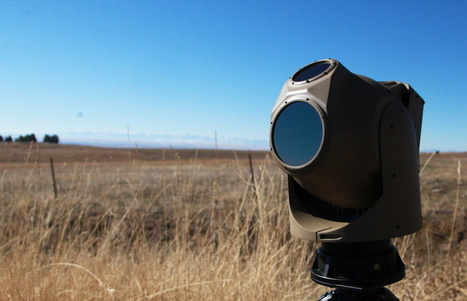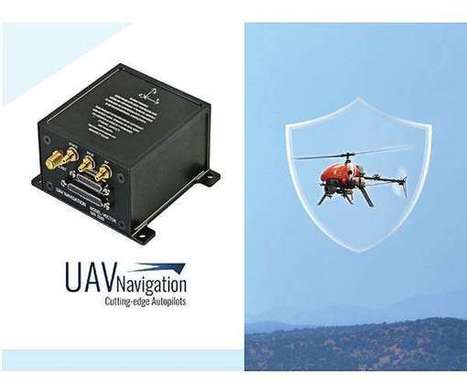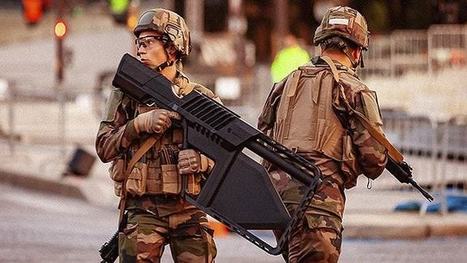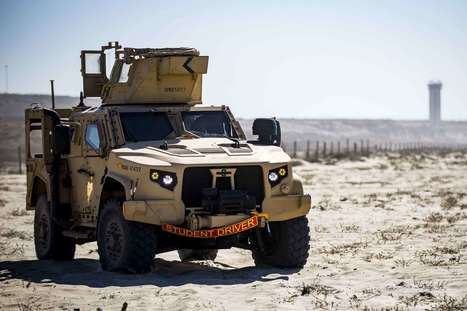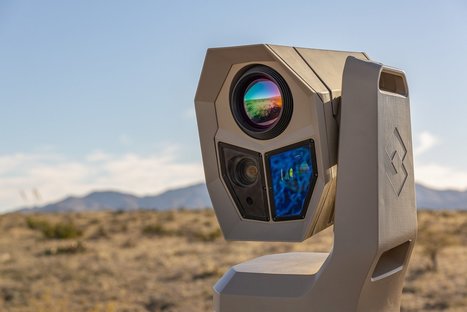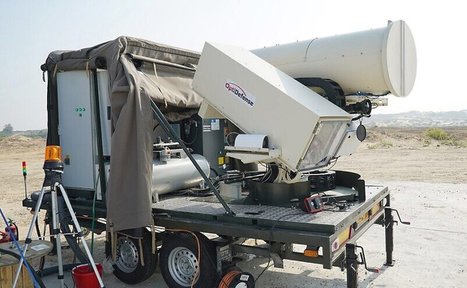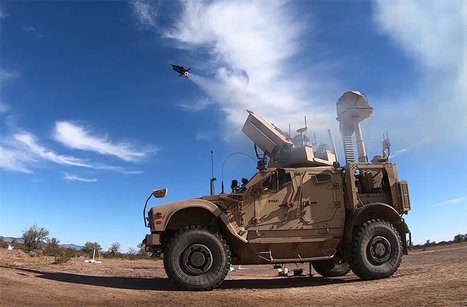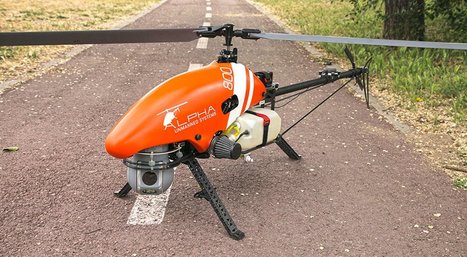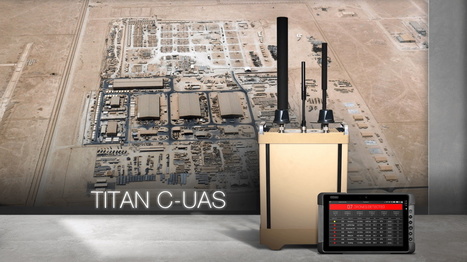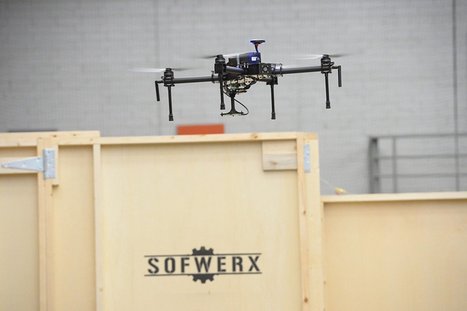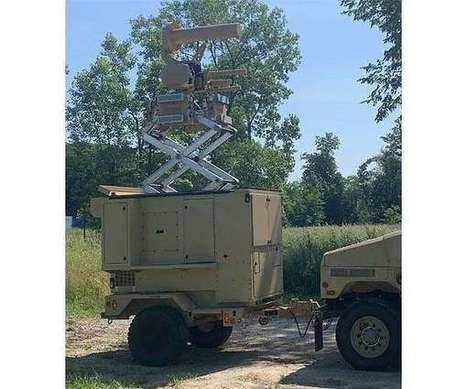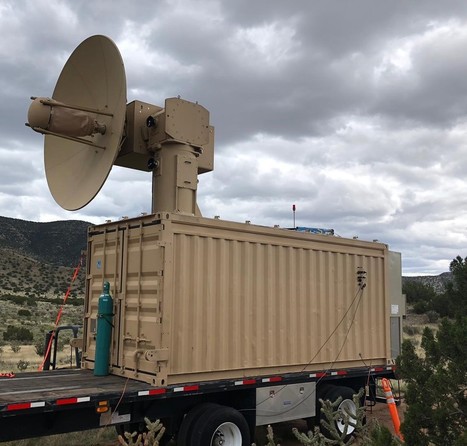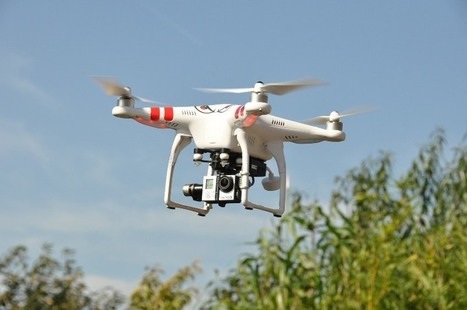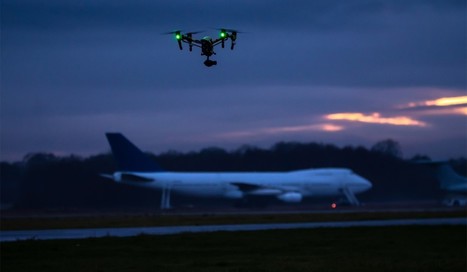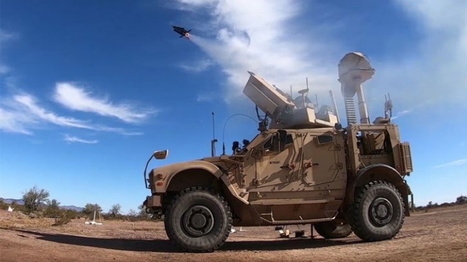 Your new post is loading...
 Your new post is loading...

|
Scooped by
Romain
June 11, 2020 12:13 AM
|
Dans le domaine de la surveillance, l'analyse de données collectées par des capteurs au sol représente une réelle valeur ajoutée pour les opérateurs. DroneShield a développé une plateforme capable d'analyser les informations recueillies.
Lutte anti-drones.
DroneShield, qui est parvenu à se positionner comme un acteur de taille dans le domaine de la lutte anti-drones, a présenté le 24 mai sa nouvelle solution : DroneOptID. Il s'agit d'un logiciel capable d'analyser les données collectées par les caméras afin d'accompagner les opérateurs dans la détection, l'identification et le suivi de drones malveillants.
Intelligence artificielle.
Pour cela, la solution DroneOptID intègre de l'intelligence artificielle, capable de repérer des éléments à valeur ajoutée à partir des images collectées par les caméras. Les algorithmes sont orientés vers la détection de drones afin de faciliter le travail de l'opérateur et réduire le taux de fausses alertes.
Caméra.
Si le système DroneOptID permet de compléter la gamme de solutions anti-drones DroneShield, ce logiciel est compatible avec toutes les caméras du marché employées pour la surveillance et la détection de drones. Par ailleurs, DroneOptID peut être intégré directement au sein d'un C2 et permet ainsi d'accompagner les décideurs en leur fournissant l'information la plus juste, en temps réel.

|
Scooped by
Romain
June 10, 2020 3:33 AM
|
Ascent Vision Technologies (AVT) has entered into an agreement with a United States Department of Defense customer to provide numerous units of the company’s CM262 and CM202U ground-based imaging systems. These advanced multi-mission systems will be used to provide advanced Intelligence, Surveillance and Reconnaissance (ISR) and Counter-small Unmanned Aerial Systems (C-sUAS) capabilities to combat forces.
The CM262 is a Full HD four-sensor unit that combines next-generation video processing and state-of-the-art stabilization technologies to provide enhanced situational awareness. The compact, man-portable, 26 pound system incorporates HD electro-optical, HD Mid-Wave Infrared (MWIR) and Short-Wave Infrared (SWIR) sensors, as well a laser range finder. It provides highly accurate target detection, recognition and identification both during the day and at night.
The CM202U is a 12-pound optic system, originally designed for portable counter-UAS missions, that provides reliable target detection, recognition and identification with an HD electro-optical sensor and MWIR core. Since its successful introduction, the CM202U has continued to be refined by AVT to offer a powerful solution for ISR and C-sUAS.
Lee Dingman, AVT President, commented: “These contracts are the result of previous successful utilizations by our customers. The CM262 and CM202U imaging systems are providing advanced capabilities to our forces. We are proud that our technology is successfully supporting a wide range of operations.”

|
Scooped by
Romain
June 5, 2020 4:09 AM
|
by Staff Writers
San Sebastian, Spain (SPX) Jun 05, 2020
.
Meaconing, Intrusion, Jamming, and Interference (MIJI) is one of the most discussed topics when it comes to UAV operations. It refers to the interception and rebroadcast of signals that are more powerful than the ones used to navigate the aircraft. Although this type of attack can be possible on any type of signal with a stronger one, it mainly affects the GNSS.
UAV Navigation has ramped up its security measures by designing a very robust system from both hardware and software perspectives. The quality of the components and their special designs help mitigate the impact of certain high-power signals. For example, our hardware is certified to MIL-STD-810F and MIL-STD-461F. This proves that the system has been tested by an independent party that certifies its level of adequacy.
From a software point of view, UAV Navigation's systems can resist interception due to two main reasons: the non-dependence of GNSS for critical system loops, which allows us to continue operating despite not being able to use GNSS and the multiple cross supervisory logics.
Also, the UAV Navigation property ICD (Interface Control Document) that our system incorporates, allows the system to prevent, analyze, and detect any possible interference or system failure.
This involves having multiple high-quality sensors (independent observers) on board and developing advanced estimation logics. Many manufacturers prefer the quickest and cheapest tactic and end up delegating too much logic to the GNSS. That makes the platform more vulnerable to attacks.
After receiving a request from one of its clients, UAV Navigation carried out robustness tests of an ALPHA 800 rotary-wing platform from the company Alpha Unmanned Systems, which uses our flight control solution.
For this, the services of a company specialized in anti-drone jamming guns were hired. Despite testing with different models and powers, the result could not be more satisfactory: the system was able to detect the interferences and continue operating without any major issues.
So, to minimize the possibility of MIJI, there are a few things that a customer must seek clarifications about. That includes:
+ What EMI / EMC tests have their system passed?
+ What mechanisms have been implemented to identify and mitigate these attacks?
+ To what extent does it affect loss from these subsystems to the global performances?

|
Scooped by
Romain
May 25, 2020 2:51 AM
|
DroneShield’s DroneGun Tactical system has been selected as the preferred counter-UAS (unmanned aerial system) solution for a range of police forces across the European Union. The tendering and selection process was run by Belgium Police, with an EU-wide framework.
DroneGun Tactical is a portable counter-drone system that is shaped like a rifle for easy one-person operation. With an effective range of up to 2 km under a variety of conditions, the system allows for a vertical controlled landing of the target drone, or return to starting point as an aid to tracking the operator. It jams video transmission back to the drone operator and also features optional GNSS disruption capability.
Sales, training and local support for DroneGun Tactical will be managed by DroneShield’s Benelux region partner, ForcePro BV. Under the framework agreement, DroneShield expects sales over an extended period of time, and also expects the agreement to serve as a platform for sales of its other products, such as the body-worn RfPatrol drone detection device and its vehicle-mounted and fixed-site counter-drone products, to EU police departments.
Oleg Vornik, CEO of DroneShield, commented: “This is an exciting win in a number of ways. This is the first framework rollout of counterdrone equipment by any Government customer, anywhere in the world. In addition to the substantial nature of this contract, we expect for this to set a standard for DroneGun Tactical procurement by other Government customers in the EU and globally, helping to fast-track additional acquisitions.”
“This selection by a highly demanding customer, following on the UK Government CPNI certification last year, reinforces the world-leading position of our products in the industry. Importantly, this win of the competitive tender by DroneShield illustrates that security is at the forefront of governments globally as well as the fact that, after a brief interruption caused by the COVID crisis, global procurement processes have resumed.”

|
Scooped by
Romain
May 4, 2020 6:55 AM
|
The Lithuanian Ministry of National Defence (MoD) has purchased an undisclosed number of counter-unmanned aircraft systems (C-UAS) to support operations both at home and abroad, defence sources told Jane’s .
Following a two-year programme, the MoD selected several systems from Danish C-UAS specialist MyDefence Communications to support dismounted and vehicle operations as well as the protection of main and forward operating bases.
MyDefence Communications has designed the Wingman-105 C-UAS system with an internal battery for size, weight, and power savings in the dismounted role. (MyDefence Communications)MyDefence Communications has designed the Wingman-105 C-UAS system with an internal battery for size, weight, and power savings in the dismounted role. (MyDefence Communications)
Selections include the Wingman-105 Small Handheld/Wearable Drone Detector and Watchdog 200 Networked RF Sensor. Deliveries of both C-UAS products are expected to be completed by September 2020, industry sources added.
The latest variant in the Wingman series, the 105 model, has been designed as a standalone UAS detection system for special operations forces, according to MyDefence Communications.
The company’s CEO, Dan Hermansen, said the Wingman-105 is an upgrade of the Wingman-100 and designed for a wider range of “operating temperatures to match the harsh mission environments all over the globe”. He also confirmed Lithuania would be the first customer for the Wingman-105.
The Wingman-105 comprises a smaller form factor and lower all-up weight over the legacy 100 model, enabled in part through the design of an internal battery supply that can be charged by an AC/DC net adaptor, a company official told Jane’s .
Designed to provide personnel with an alert of UAS activity during an evaluation period, the Wingman-105 demonstrated its capability to detect UASs at ranges in excess of 1 km depending on environmental conditions, defence sources explained.
The Wingman-105 includes 60° directional 2.4 GHz and 5.8 GHz ISM band antennas and can be networked to command-and-control (C2) devices including the US Department of Defense’s Android Tactical Assault Kit (ATAK).
The system can also be upgraded with the AA100 External Active Antenna (AA100) omnidirectional antenna for 360° coverage, depending on end-user requirements.
Hermansen revealed to Jane's that the company is also designing a new accessory for the Wingman-series of products.

|
Scooped by
Romain
May 4, 2020 5:57 AM
|
Ascent Vision Technologies (AVT) has released a new version of its eXpeditionary Mobile Air Defense Integrated System (X-MADIS), a counter-UAS (unmanned aerial system) solution for portable, on-the-move and vehicle-mounted applications.
AVT continues to adapt its systems to the growing threat posed by small UAS, and this new variant of the X-MADIS features several new hardware components for improved ruggedness and on-the-move accuracy in rough terrain, as well as improved power distribution and simpler setup and deployment. The X-MADIS combines air surveillance radars with an optical payload and a radio frequency (RF) detection sensor for reliable detection, classification and locating of a wide range of commercial drones.
Users can select from multiple electronic warfare systems to tailor the X-MADIS to specific missions and defeat UAVs and drone swarms. Two gyro-stabilized optics are available for integration, including the CM262 4-configuration, 26lb payload and the field-proven CM202U 12lb payload. Both optics are enhanced with smart features, artificial intelligence and machine learning capabilities for improved situational awareness.
AVT’s CUAS Suite software provides seamless command and control of all components and features of the X-MADIS with an intuitive touchscreen interface.
“Our top priority is keeping our customers better protected against the threat, which is why we continually deliver upgrades to the X-MADIS system,” said Lee Dingman, AVT President. “This latest X-MADIS version is the result of three years of development, testing and integration of new and improved features and components. Our Counter UAS team is responsive to our customers’ demands, and we constantly evaluate the future threat to keep our customers ahead of their enemies.”

|
Scooped by
Romain
April 21, 2020 2:31 AM
|
Citadel Defense has upgraded its AI (artificial intelligence)-based Titan counter-drone solution to detect, identify, and defeat unmanned systems on land or at sea, such as UGVs (unmanned ground vehicles) and USVs (unmanned surface vehicles), as well as UAVs (unmanned aerial vehicles). Titan uses enhanced sensor fusion technologies to overcome limitations often common to radar or cyber-takeover-based systems that are caused by ground clutter or unfamiliar new threats.
Citadel has remained responsive with upgrades to their versatile algorithms, providing force protection against surface-based threats and ground robotic platforms as well as small unmanned aerial systems. These threats are creating challenges for military and security teams that legacy electronic warfare and most C-UAS systems fail to address.
Citadel’s new updated software will be rolled out to over a hundred existing Titan systems already in the field. Titan’s open architecture ensures that the breadth of capability and protection offered by the system can be integrated into any layered system acquired by U.S. military, government, or commercial customers.
Christopher Williams, CEO of Citadel Defense, commented: “Unmanned systems have changed the landscape of military, intelligence, and security operations. We must think beyond aerial threats when protecting personnel and sensitive critical infrastructure. If our military is using RC-controlled platforms across each domain, we must expect that our adversaries will too.”
“We used cognitive technologies including robotic process automation, AI, and deep learning from the very beginning of our development two years ago. End user and environmental feedback refined our models allowing us to deliver a nimble system with immediate software patches to stay ahead of our adversaries. Having this capability effective across fixed, mobile, and dismounted operations is a disruptive technology that meets the doctrinal needs of our military.”

|
Scooped by
Romain
April 10, 2020 2:22 AM
|
The Marine Corps wants to know whether the defense industry can transform its heavy weapons-mounted Joint Light Tactical Vehicles into mobile air defense systems for tracking and killing enemy drones, helicopters and fighters.
Marine Corps Systems Command recently invited defense firms to submit ideas for creating the Direct Fire Defeat System being developed by Program Manager Ground Based Air Defense, according to a March 27 request for information.
The program is designed to arm Marine air-ground task force commanders with JLTVs equipped with anti-aircraft missiles, 30mm cannons and electronic warfare technology to "detect, track, identify, and defeat aerial threats," the solicitation states.
"This system will provide new and improved capability to mitigate the risk of attacks from Unmanned Aerial Systems and Fixed Wing/Rotary Wing aircraft while maintaining pace with maneuver forces," according to the document.
The U.S. military has begun to beef up its air defense capabilities as it prepares for a possible future war against near-peer militaries with sophisticated aviation capabilities.
The Army is in the process of modernizing its air-defense units with the Maneuver Short-Range Air Defense (MSHORAD) system, which will feature Stryker combat vehicles armed with Hellfire missiles, a 30mm chain gun, a 7.62 machine gun and four Stinger missiles.
The Army is also working on equipping a platoon of four Stryker vehicles with 50-kilowatt lasers that are capable of engaging drones and combat aircraft, as well as rockets, artillery and mortars in fiscal 2022.
The Marine Corps' direct fire system will be part of the initial phase of the Marine Air Defense Integrated System, or MADIS, which will feature the command-and-control software integrated into Mk1 and Mk2 variants of the Corps' JLTV Heavy Guns Carrier, according to the document.
The MADIS Mk1 features turret-launched Stinger missiles, multi-functional electronic warfare capability and a direct-fire weapon such as a 30mm cannon on a remote weapons station. The MADIS Mk2 will be the counter-UAS variant, with a 360-degree radar and command-and-control communications equipment, in addition to a direct-fire remote weapons station and electronic warfare tech.
The Mk1 and Mk2 form a complementary pair and are the "basic building block" for modernizing the service's Low Altitude Air Defense Battalions, according to Marine Corps Systems Command's website.
The Marine Corps last year deployed its Light Marine Air Defense Integrated System, or LMADIS, using it to jam an Iranian drone that flew near a Navy warship in the Strait of Hormuz.
Companies have until April 13 to submit proposals, including proof that they are capable of delivering 26 systems in support of low-rate initial production in the third quarter of fiscal 2021, as well as 192 systems in the third quarter of fiscal 2022, according to the document.
-- Matthew Cox can be reached at matthew.cox@military.com.

|
Scooped by
Romain
April 1, 2020 3:38 AM
|
The Australian company DroneShield has revealed that it has delivered its DroneGun unmanned aerial vehicle (UAV) countermeasures system to a Middle Eastern military.
"Following a request by its governmental customer, it has shipped the remainder of the DroneGun Middle Eastern Ministry of Defence order," the company said in a statement released on 30 March.
It did not identify the military that received the system, but quoted its CEO as saying, "Middle Eastern customer order flow processes are often less structured than those involving their Western counterparts. However, DroneShield has a close relationship with this governmental customer and has received multiple payments from this governmental customer before, and therefore has a high degree of confidence in the process."

|
Scooped by
Romain
March 23, 2020 3:31 AM
|
FLIR Systems, a company that specializes in the production of thermal imaging cameras, has announced that it launched a new high-definition midrange surveillance system, called the Ranger HDC MR.
The Ranger HDC MR sets a new standard for surveillance with its ability to detect illegal activities even in degraded weather conditions, utilizing embedded analytics and image processing to reduce the cognitive workload, enabling operators to distinguish quickly between true threats and false alarms.
The FLIR Ranger HDC MR is a high-performance HD thermal imaging system for about the same price as standard resolution systems. Compared to standard systems, Ranger HDC MR can capture a wider array of views with the same target resolution, thanks to its HD imagery. Mission capability is extended two-fold with a built-in fog filter to see through fog and haze, as well as an optional Merlin ASX turbulence filter to see through heat/air turbulence for more accurate target classification. Ranger HDC MR also is ready to host on-board AI image processing for faster decision-making. Its advanced technology improves reliability while lowering downtime and maintenance with a lifelong core that more than doubles the mean-time between failures of previous models.
“Whether securing borders, ports, facilities or troops, the FLIR Ranger HDC MR delivers a new level of surveillance so operators can act fast against threats,” said David Ray, president of the Government & Defense Technologies business at FLIR. “This new system can eliminate days of inefficient surveillance by using on-the-edge technology to see through poor weather conditions, increasing up-time. Our powerful Ranger HDC MR offers customers a cost-effective solution that boosts mission success.”
Equipped with a high-definition thermal imager with a 1280 x 720 detector and a 1920 x 1080 HD color TV camera, the Ranger HDC MR is designed for integration with other sensors, making it ideal for counter-unmanned aerial system (C-UAS) applications. The AI-ready HDC MR also includes an industry leading cybersecurity tool that lowers risk by scanning each software release to help ensure the system is protected from cyber-attacks.
* If you wish to report grammatical or factual errors within our news articles, you can let us know by using the online feedback form.

|
Scooped by
Romain
March 20, 2020 4:53 AM
|
Recent Israeli media reports indicate that the Light Blade (Lahav-Or) counter-UAS (C-UAS) system, developed by startup company OptiDefense, showed impressive results in field trials against balloons launched from the Gaza Strip.
The laser-based Light Blade was developed by three civilian engineers working with researchers from Ben-Gurion University, the technology branch ...

|
Scooped by
Romain
March 19, 2020 3:22 AM
|
Unmanned aerial vehicles (UAV), commonly known as drones, are widely used in mapping, aerial photography, rescue operations, shipping, law enforcement, agriculture, among other things. Despite great potential for improving public safety, use of drones can also lead to very undesirable situations, such as privacy and safety violations, or property damage. There is also the highly concerning matter of drones being harnessed to carry out terrorist attacks, which means a threat to public safety and national security.
Radar technology is one of the solutions to monitor the presence of drones and prevent possible threats. Due to their varying sizes, shapes and composite materials, drones can be challenging to detect.
Researchers from Aalto University (Finland), UCLouvain (Belgium), and New York University (USA) have gathered extensive radar measurement data, aiming to improve the detection and identification of drones. Researchers measured various commercially available and custom-built drone models' Radar Cross Section (RCS), which indicates how the target reflects radio signals. The RCS signature can help to identify the size, shape and the material of the drone.
'We measured drones' RCS at multiple 26-40 GHz millimetre-wave frequencies to better understand how drones can be detected, and to investigate the difference between drone models and materials in terms of scattering radio signals. We believe that our results will be a starting point for a future uniform drone database. Therefore, all results are publicly available along with our research paper,' says the author, researcher D. Sc. Vasilii Semkin.
The publicly accessible measurement data can be utilised in the development of radar systems, as well as machine learning algorithms for more complex identification. This would increase the probability of detecting drones and reducing fault detections.
'There is an urgent need to find better ways to monitor drone use. We aim to continue this work and extend the measurement campaign to other frequency bands, as well as for a larger variety of drones and different real-life environments,' Vasilii Semkin says.
Researchers suggest that 5G base stations could made in the future for surveillance.
'We are developing millimetre-wave wireless communication technology, which could also be used in sensing the environment like a radar. With this technology, 5G-base stations could detect drones, among other things,' says professor Ville Viikari from Aalto University.

|
Scooped by
Romain
March 18, 2020 4:17 AM
|
Raytheon expects to begin full-rate production of Coyote Block 2 (pictured), a counter-UAS (C-UAS) UAV which is used with the Howler C-UAS system, in 2020.
The company also expects to achieve IOC of the UAV with the US Army this year.
Howler currently uses the Ku-Band Radio Frequency System (KuRFS ...
|

|
Scooped by
Romain
June 10, 2020 3:38 AM
|
Côte d'Ivoire, Liban mais aussi Syrie et Irak : l'Armée de Terre a été directement prise à parti à très basse altitude par des menaces aériennes. Elle doit donc réagir.
La menace des mini-drones armés
Côte d’Ivoire, Liban mais aussi Syrie et Irak : l’Armée de Terre a été directement prise à parti à très basse altitude par des menaces aériennes contre lesquelles elle n’a pu lutter, faute de moyens. Dans le Donbass et plus récemment, en Arabie Saoudite, elle a aussi vu des armées très équipées prendre des coups très durs avec des menaces symétriques ou asymétriques. Elle doit donc réagir car ses moyens en dotation ne permettent plus d’assurer la défense à très basse altitude contre des objets compacts et potentiellement très destructeurs comme des mini-drones armés. Ces engins sont l’équivalent des IED (engins improvisés) qui ont piégé les routes à partir de 2003, avec des composants très sommaires. Une protection efficace serait déjà difficile contre une base fixe, et encore plus pour un convoi mobile, même s’il disposait de missiles anti-aériens, qui ne peuvent être tirés que depuis un trépied, et non à l’épaule.
Les TOP de Kongsberg
L’Armée de Terre, consciente du défaut de cuirasse, a lancé via sa section technique (STAT) une adaptation réactive mobilisant les tourelleaux télé-opérés (TOP) Kongsberg acquis durant la guerre d’Afghanistan, et implantés à l’avant droit des véhicules de l’avant blindé (VAB) déployés au Sahel. La STAT a demandé à la société norvégienne d’adapter la conduite de tir à la détection et la poursuite d’objectifs très petits comme des mini-drones et micro-drones. Couplés à des mitrailleuses de 12,7 mm et en partant du principe que la détection des ces cibles bien moins rapides qu’un jet ou un hélicoptère pourra être réalisée de façon précoce, le système peut ainsi être adapté relativement simplement et à moindre coût.
"Mini-guns" M134 gyrostabilisés
Cette première réponse, pratique, devrait, idéalement, enclencher une opération d’ensemble plus englobante qui mêle réponse de très court terme et à bas coût, et réponses de moyen terme plus complètes. Une des pistes, prometteuses, est d’utiliser des mini-guns M134 gyrostabilisés sur une conduite de tir. La version basique de la M134 est déjà en service dans les forces spéciales, sur Gazelle, au 4e RHFS, mais aussi sur les véhicules des unités commandos et sur une poignée de navires de la Marine. Evidemment, une des problématiques, et non des moindres, tient dans la détection, qui pourrait être réalisée par les radars Murin de Thales livrés l’an dernier au Sahel. L’autre point dur étant dans le concept d’emploi : car plusieurs centaines de cartouches de M134 pourrait avoir un impact très destructeur sur un aéronef ami qui passerait à portée. Une déconfliction préalable serait donc nécessaire, dans un délai qui serait, dans tous les cas de figure, particulièrement réduit.

|
Scooped by
Romain
June 8, 2020 5:07 AM
|
UAV Navigation reported on 4 June that it is testing its autopilot software against a C-UAS after a receiving a request from one of its customers.
Robustness tests were performed on the Alpha 800 UAV (pictured) which uses UAV Navigation’s flight control solution. The system was able to detect ...

|
Scooped by
Romain
June 2, 2020 2:11 AM
|
Citadel Defense, a developer of full-spectrum counter-drone solutions, has released new software that uses deep learning neural networks to protect against hostile spoofing tactics. This capability will help U.S. and allied forces to fight against growing enemy tactics that attempt to confuse existing security intelligence equipment by using drone-based electronic warfare systems.
Citadel has integrated Generative Adversarial Networks into its Titan C-UAS (counter unmanned aerial systems) solution, using proprietary image generation algorithms to develop discrimination classification models that help determine whether detected signals are real drones, or signals generated for the purpose of tricking existing signal intelligence equipment.
As the use of drones and unmanned surface vessels (USVs) increases in battlefield environments, Citadel is rapidly equipping militaries and governments with cutting-edge capabilities to stay ahead of weaponized drone threats. Recently, Citadel has trained over 500 military and law enforcement operators on emerging adversarial threat tactics and Titan technology. Over 100 Titan systems in the field are being updated with the company’s latest software release.
Christopher Williams, CEO of Citadel Defense, commented: “Just like anti-virus programs have methods to detect software exploits, Titan has automated methods that proactively defend against spoofing exploits. Adding new deep learning capabilities to Titan helps blind the drone-equipped enemy and deny them any advantage or safe haven in contested and complex radio-frequency environments.”
“At Citadel, our solution design principles are providing comprehensive, scalable, intuitive, mission-proven and AI-powered capability with unprecedented speed to the customer.”

|
Scooped by
Romain
May 12, 2020 3:22 AM
|
US Special Operations Command (USSOCOM) is seeking industry white papers for its C-UAS Systems Integration Partner (CUxS SIP) requirement.
In an RfI published on 17 April, USSOCOM identified ongoing market research ‘which will be used to plan and implement an acquisition strategy’ in connection with integration of a CUxS family of systems (FoS), with an initial focus on C-UAS.
The announcement identifies a range of expected CUxS SIP responsibilities, including integration of a family of C-UAS sensors and systems, both government-owned and vendor-recommended (based on the set of sensor requirements provided by the government), to provide a layered defence for SOF operators in various overseas environments.
Other responsibilities include provision of modular and scalable recommendations on the optimal sensor/system package for a given mission set or deployment location, based on government-provided intelligence, operator inputs, site surveys, and their own expertise of the various available sensors; and co-ordination with a US federal government logistics team in the fielding of packaged solutions.
Additional identified responsibilities range from field service support at overseas locations to maintenance activities on the sensors and systems within the FoS.
While the US military has developed a number of C-UAS systems and capabilities over recent years, the scenarios associated with SOF operators frequently mandate a small logistics footprint that limits the employment of some systems. These challenges were highlighted in mid-2017 reports that Islamic State fighters were using small commercial drones and swarm tactics to attack US special operations forces in Syria.
By early November of that year, USSOCOM, in conjunction with its SOFWERX experimental unit, had conducted what it described as its first ‘rapid prototyping event’ (RPE) tailored towards ‘rapid drone technology development for warfighter advantage’. The RPE process would soon shift toward countering these increasingly prevalent platforms.
In terms of countering small commercial drones and other unmanned systems in tactical environments, some of the thinking in this period involved the expansion of ECM programmes that were designed to defend against IEDs.
Evidence of this can be found in USSOCOM’s FY2019 budget estimates, released in February 2018, which called for an evolving ECM capability to counter emerging threats from UASs.
USSOCOM/SOFWERX conducted the second RPE (dubbed “ThunderDrone”) at about the same time. The RPE drew participants from more than 90 companies to showcase their capabilities across all phases of an identified C-UAS kill chain.
Companies offering technologies and capabilities that align with warfighter needs were subsequently invited by SOFWERX to participate in outdoor demonstrations at Fort Bragg in April 2018.
Based on the outcome of those demonstrations, top participants were then invited to RPE III – called “ThunderDrone: Game of Drones”. Conducted at Nellis AFB in mid-June 2018, the event helped to further mould the CUxS FoS for USSOCOM.
The recent RfI for white papers from the systems integration industry identifies an anticipated competition in the Q3 2020, with an estimated contract award date late in Q1 2021.

|
Scooped by
Romain
May 4, 2020 6:15 AM
|
Liteye Systems, Inc., is a Colorado-based, world-leader in Counter Unmanned Aerial Systems (CUAS). Liteye manufacturers multiple combat proven configurations for the US DoD that are highly effective in protecting lives and critical infrastructure around the globe. With over $100 Million in Government contracts, Liteye is a leader in the Counter UAS market.
Together with their Colorado based teammate Numerica, Liteye has seen significant success in approaching the UAS problem-set through a collaborative and layered strategy.
"We recognize a need for our systems to integrate with higher level C2 networks, but we also appreciate the need for our systems to work effectively by itself or directly with other systems and sub-systems depending on the mission," said Ken Geyer, CEO of Liteye Systems.
Liteye's US AUDS (Anti UAS Defense System) is a combat proven Counter UAS solution with multiple layered technologies to detect, track, identify and defeat malicious threats.
Portions of this layered approach have been used to push critical information through higher-level networks to improve situational awareness and has also been purpose-linked directly to other weapon systems to cue them on to a target.
Recently, Liteye has provided Raytheon Missiles and Defense in Albuquerque NM, a purpose-built system to visually identify, target and cue Raytheon Missiles and Defense's Phaser High Powered Microwave system to an intended target. Raytheon Missiles and Defense's Phaser system is a state-of-the-art system capable of permanently damaging UAS before it damages critical infrastructure or personnel.
"We were pleased to be a chosen supplier to Raytheon Missiles and Defense and look forward to providing them the additional layers needed to be effective against all types of small UAS," said Geyer.
In past events held by the US government, Liteye's layered Counter UAS solution has also been used to successfully place the 30mm x 113mm Cannon system on a positively identified UAS target.
"In combination with other weapon systems like the 30mm Cannon, or Raytheon Missiles and Defense's Phaser, Liteye continues to be extremely successful in eliminating a drone, even in difficult flight engagements," said Geyer.

|
Scooped by
Romain
April 29, 2020 2:56 AM
|
L'USAF va expérimenter de nouveaux systèmes de lutte anti-drones, basés sur la technologie laser.
Evaluer des matériels.
L'US Air Force, et plus spécifiquement l'Air Force Research Laboratory, va mener une expérimentation de 12 mois afin d'évaluer différents systèmes de lutte anti-drones. Tous ont un point commun : ils s'articulent autour de systèmes à énergie dirigée, permettant de détruire et neutraliser les drones hostiles. Cette expérimentation fait suite à une première évaluation remontant à 2018 qui visait à mettre en œuvre des systèmes à énergie dirigée.
Solutions industrielles.
Au total, cinq solutions devraient être évaluées. L'Air Force Research Laboratory (AFRL) a annoncé que parmi ces systèmes figuraient ainsi le HELWS (énergie laser) et le PHASER (micro-ondes), tous deux développés par Raytheon. Mais une solution maison sera également évaluée, le système THOR (Tactical High Power Operational Responder), entièrement développé par l'Air Force Research Laboratory. « THOR, avec sa technologie de neutralisation électronique permet de faire face à un essaim de drones très rapidement. Cette capacité représenterait un atout majeur pour nos combattants et la défense de notre pays », ajoute l'AFRL.

|
Scooped by
Romain
April 21, 2020 2:23 AM
|
Retour sur le dossier lutte anti-drones réalisé par Air & Cosmos en janvier dernier avec une interview du général Vincent Cousin et une revue des différents moyens sur le marché.
Le dossier consacré à la lutte anti-drones commence par une interview du général Vincent Cousin, commandant de la Défense aérienne et des opérations aériennes.
• Comment l’Armée de l’Air se positionne-t-elle sur les segments de la détection, de l’identification et de la neutralisation ?
Au titre de la mission de sûreté aérienne, en particulier dans les bulles de protection, il est de la responsabilité du CDAOA de protéger le sol de toute menace aérienne, y compris des drones. Pour la lutte anti-drones, nous adaptons l’organisation générale de nos dispositifs. On pourrait parler d’espaces aériens gigognes, composés d’une bulle principale de protection permanente au-dessus de la France entière. Lors d’événements particuliers – comme à Biarritz, lors du Sommet du G7 d’août dernier –, nous créons une bulle temporaire pour faire face à des menaces de type ULM, avions commerciaux, avions de tourisme.Au sein de cette dernière, il existe une bulle encore plus particulière – plus petite mais pas moins essentielle – pour la lutte anti-drones. Cette bulle dispose de ses propres règles d’engagement. Nous adaptons nos processus décisionnels en fonction de la situation.......
• D’après vous, quelles sont les principales menaces dans le domaine de la lutte anti-drones et les défis auxquels le CDAOA doit faire face ?
La 5G et la fulgurance de la transmission des données qui va y être associée pose, entre autres, la question des menaces en essaim. Parallèlement, nous devons être capables de faire face à des drones à navigation inertielle. Nos systèmes de neutralisation devront être adaptés, anticipant la menace, ce sur quoi nous travaillons d’ores et déjà. Nous pensons qu’en fonction de la distance de la menace, nous pouvons faire évoluer le moyen de neutralisation et combiner les outils présents ou émergents. La menace est tellement évolutive que c’est l’innovation et les processus courts d’acquisition qui nous feront rester au plus près de cette menace pour la traiter. C’est ce travail que nous menons avec l’AID (Agence Innovation Défense) et qui nous a permis de nous équiper d’une première capacité expérimentale a n de mûrir des concepts d’opération......
• Sur le plan de la neutralisation, nous constatons l’émergence des systèmes laser et à micro- ondes. Comment la France se positionne-t-elle sur ces technologies ?
Sur la Base aérienne 701 de Salon-de-Provence, nous nous appuyons sur le pôle drones de l’armée de l’Air, le Cifed (Centre d’initiation et de formation des équipages de drones). S’y trouve également le centre de recherche de l’école de l’Air, qui suit, analyse et évalue les technologies émergentes et les progrès réalisés dans le domaine de la lutte antidrones. Nous suivons de près, avec la DGA et le ministère de l’Intérieur, l’ensemble des nouvelles technologies. Les systèmes laser et à micro-ondes en font partie. Dans le respect de la réglementation,nous réalisons des expérimentations en conditions réelles, sur la Base aérienne de Salon-de-Provence.......
Article complet à (re)découvrir en téléchargeant le fichier ci-dessous.

|
Scooped by
Romain
April 8, 2020 6:19 AM
|

|
Scooped by
Romain
April 1, 2020 3:13 AM
|
Small drones are increasing concern for militaries and security forces across the world, as their low altitude and small size makes them hard to track or see.
Small drones are increasing concern for militaries and security forces across the world, as their low altitude and small size makes them hard to track or see. After the Gatwick Airport incident in the UK in 2019, it became clear that these systems, although cheap, can wreak havoc on infrastructure. Much counter-drone technology has been developed in response to the incident, including Qinetiq’s Obsidian system.
As this video from the company demonstrates, the system uses low-cost 3D radar to track and discern between threats so they can be either engaged if they present a risk, or ignored if they do not. The technology for the system derives from the ALARM system used by the British Army to provide warning of impending aerial attacks.
A chief function of the system is the ability to maintain tracking while a target is stationery or hovering by detecting the rotation of a small UAV’s rotor blades, reducing the chances of classifying another object as a drone.
The system has already been deployed in a commercial capacity, and last October, Qinetiq began trials with the system in Canada.
QinetiQ Canada managing director Robert Aubé said: “Obsidian counter UAS is specifically designed to meet the current and forecast threat of drone incursion upon critical national infrastructure, including daily operations in complex environments such as the Ottawa Macdonald-Cartier International Airport.”

|
Scooped by
Romain
March 20, 2020 5:02 AM
|
Raytheon Co., one of the world's largest defense contractors, said the new Coyote Block 2 counter-drone weapon approved for international

|
Scooped by
Romain
March 20, 2020 4:13 AM
|
Hensoldt, a defence and security sensor specialist, and Air Traffic Management (ATM) solutions provider Frequentis have announced that the two companies are working together to develop new integrated counter-UAS (unmanned aerial system) solutions for airports.
Frequentis will contribute expertise and technologies from the fields of UTM/ATM/drone detection, data fusion and exchange (MosaiX SWIM), shared situational awareness and ATM-grade surveillance data automation (SDDS-NG, MSDF, PRISMA), cross-agency incident management (ICM), and operational requirement analysis. Hensoldt will provide detection, identification and mitigation modules from their existing Xpeller counter-UAS system.
Both companies have already been collaborating on the FALKE project, which aims to develop the ability to intercept small drones that enter restricted airspaces at airports. Hamburg Airport will be the model for the new solution, with the partners demonstrating a technical and organisational concept to defend against illegally operating drones.
The FALKE project consortium also includes the German Federal Police, German Air Traffic Control (DFS), Lufthansa, Hamburg Airport, and the chair of electrical measurement of the Helmut Schmidt University (HSU) in Hamburg.
Günter Graf, Frequentis Head of Business Development, commented: “The formation of this MoU further reinforces our intention to create effective solutions to differentiate cooperative and non-cooperative flying objects, ensure shared situational awareness across all organisations and interoperability with existing airport surveillance infrastructures and available UAV traffic management (UTM) systems. We are pleased to be working on this common goal with Hensoldt, combining our strengths.”
Markus Wolf, Head of Sales and Business Development at Hensoldt Ventures, said: “Together with Frequentis, we will create a modular counter-UAV system optimised for the specific needs of airports. Xpeller demonstrates Hensoldt’s innovative capabilities, answering our customer’s needs to detect and act against unmanned threats. Due to its versatility, Xpeller is able to offer maximum protection under a variety of conditions and ranges. While available as a fully functional stand-alone system, its modular approach enables us to easily join forces with partners like Frequentis.”

|
Scooped by
Romain
March 19, 2020 3:16 AM
|
Raytheon is preparing to begin deliveries of a new surface-launched counter-unmanned aircraft system (CUAS) capability to the US Army in mid-second quarter 2020, following the completion of developmental, operational, and customer acceptance testing at the Yuma Proving Ground in December 2019. The system will comprise the new Coyote Block 2 interceptor and the Ku-band Radio Frequency System (KuRFS) 360° detection and intercept radar.
In a parallel development, the US government earlier this year cleared Coyote Block 2 for Foreign Military Sales, paving the way for possible exports of the Block 2 weapon and KuRFS radars to approved allied nations. Raytheon, in conjunction with the US Army, will conduct a briefing on, and demonstration of, the Block 2/KuRFS CUAS capability to "interested foreign governments" later this year.
Under the provisions of an extended Joint Urgent Operational Need (JUON) requirement, originally issued by the army's Program Executive Office (PEO) Missiles & Space/Counter Rocket, Artillery, and Mortar Program in July 2018, Raytheon will deliver an undisclosed number of Coyote Block 2 interceptors and new, four-cell launcher units, along with new Ku-band Radio Frequency System (KuRFS) 360° detection and intercept radars. These will be coupled with the army-standard Forward Area Air Defense/Counter-Rocket Artillery Mortar Command and Control (FAAD/C-RAM C2) systems supplied by Northrop Grumman, and all elements will be integrated on the army's primary objective platform - the 4×4 Joint Light Tactical Vehicle (JLTV) - to deliver a new, ready-to-deploy tactical Howler CUAS capability for the service.
Raytheon characterises the Block 2 development as "high-end missile-like technology in a low-cost airframe". Developed in under 18 months and optimised in the CUAS role to take on Class 1-Class 3 UAS threats, the Coyote Block 2 is furnished with a blast fragmentation warhead - significantly larger than its Block 1B predecessor - specifically designed to address manoeuvring UAS threats.
|

 Your new post is loading...
Your new post is loading...
 Your new post is loading...
Your new post is loading...





